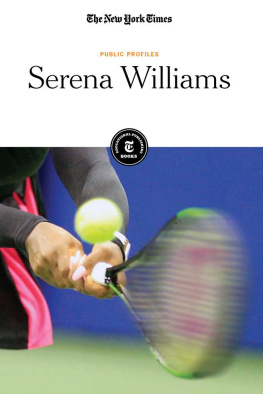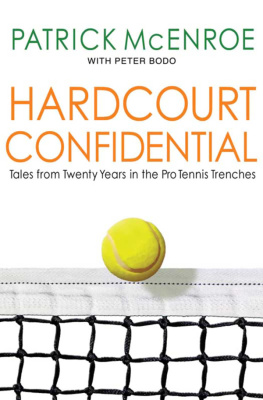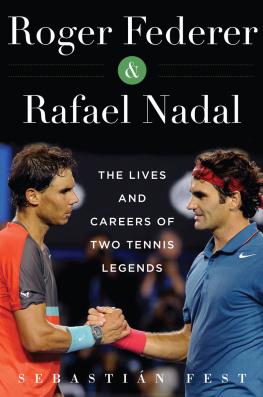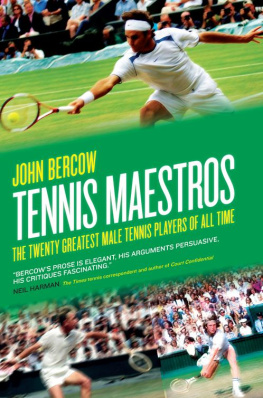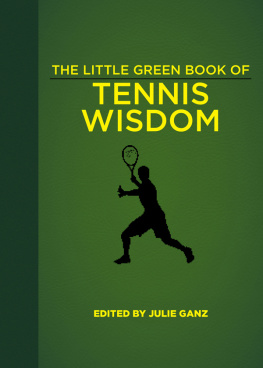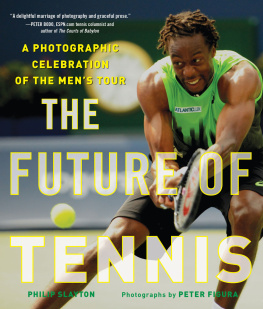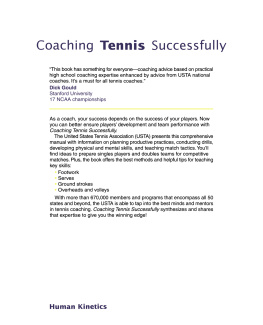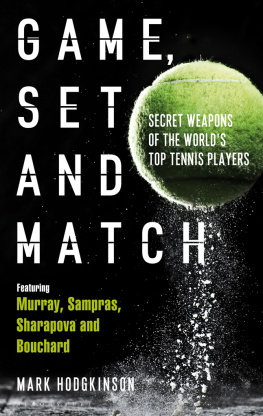Thank you for downloading this Touchstone eBook.
Join our mailing list and get updates on new releases, deals, bonus content and other great books from Touchstone and Simon & Schuster.
C LICK H ERE T O S IGN U P
or visit us online to sign up at
eBookNews.SimonandSchuster.com
Contents
I
THE EARLY EDGE:
The Match Begins Before the Match Begins
II
PLAYING SMART:
Finding a Way to Win
III
MIND GAMES, PSYCHING, AND GAMESMANSHIP:
Tales From the Tour
To a gentleman and great champion, Arthur Ashe, who fought for human dignity and the worth of the individual
Introduction
Winning Ugly in the 21st Century: The More Things Change, the More We Stay the Same
Lets test your tennis memory with this question: Who were the #1 players in the world when Winning Ugly was published in 1992? If you said Monica Seles and Jim Courier, you aced it. Plenty has changed since then, but plenty has stayed the same. I think thats why so many tennis players still come up and tell me how Winning Ugly helps their game today , many years after it was introduced to an unsuspecting tennis world.
Nothing brings a warm smile to my face and does my heart more good than when a club player or pro walks up to me at a tournament with a copy of Winning Ugly for me to sign. Great! To me, thats the ultimate compliment. And thats why I wouldnt change a word in the original edition; it still will have a powerful effect on your game. Thats my promise to you.
I would, however, add some ideas and thats what this brand new and comprehensive introduction is for, to bring Winning Ugly up to speed in the twenty-first century.
In my opinion, the three biggest changes in tennis since Winning Ugly was written are technology, court surfaces, and athleticism. (Maybe I should add a fourth: instant replaythe shot spot. Its great for the game and terrific for the fans because it satisfies our curiosity with conclusive evidence on those close calls.)
1) Technology: Those high-tech poly strings and light rackets have transformed shots by allowing pros and lots of club players to hit so much harder and create gigantic spin and angles that let them throw grenades for ground strokes and bombs for serves. (Rafael Nadals ball spins up to 5,000 revolutions per minutemore than twice as fast as Pete Sampras or Andre Agassi in their prime.) The ball is hit so hard with so much spin now that its practically deformed as it rockets over the net toward an opponent.
2) Court surfaces: the surfaces of courts worldwide are more alike than ever beforegrass is slower; clay is faster; hard courts produce more bounce. All of this makes for much better pointsmore interesting for fans to watch, and more fun for television analysts like me to talk about.
3) Finally, (and for me, the biggest change), the athleticism and resulting movement and muscularity of twenty-first-century tour players are more epic than ever.
Movement means great footwork coupled with quick speed, balance, dexterity, and flexibility both on offense and defense for as long as it takes to finish the job. It comes from advancements in conditioning and strength, among other things. Supreme fitness is a given today if you want to keep up and a top-end fitness trainer is as prized on tour as a good coach. When you combine that with the new technology you have todays super tennis played by super players.
For example, Novak Djokovicthe Djokercan run down five corners back and forthboom, boom, boom, boom, boomand then take control of the point, hit a winner, and finish up by doing the splits. He, Rafa, and others can do this for four hours. They have the amazing ability of the 20-Second Recovery. They make it look easy and it absolutely amazes me.
Im seeing the kind of points played now that just werent around twenty years ago. Its like watching a video game (or as Ive called in on ESPN2, watching Wii tennis) and it has produced players I call all-arounders who can play great from anywhere on the court. The resulting tennis is unbelievable to watch and has led to a new golden age for the sport.
Where will the game be twenty years from now? Two hundred mile-per-hour serves? It can happen. And even more amazing is that players will be returning those serves.
The face of twenty-first century tennis so far is Roger Federer. Fed seized #1 worldwide in 2004 and held it until 2008, when Nadal grabbed it for a year, then Fed again, then Nadal againand then the Djoker took over. But Feds markseventeen Slams (so far), the most ever in mens tennisis the biggest. He personally raised the bar of performance so high that he forced others to follow if they wanted to compete. Rafa and the Djoker did. Others will.
On the mens side, Ive never seen a stronger top four than Fed, Rafa, the Djoker, and Andy Murray. I doubt well see a stronger #1, #2, #3, and #4 for a long timemaybe ever.
For the women, Serena is it, although Venus is pretty amazing too. Serena and Venus are two of the best things that happened to womens tennis in the twenty-first century because they shook things up every which way. (Nevertheless, Steffi Graf in her prime would challenge either of the Williams sisters because she was so physical and had those powerful groundies, including her legendary slice backhandan executioners shot. Very tough mentally too, just like Venus and Serena.)
Old-time tennis fans like to say the 1980s produced the greatest cast of characters and performers in tennisMcEnroe, Connors, Becker, Evert, Navratilova, Lendl, Borg, and others. But todays lineup is more exciting because of the big changes I mentioned and the athletes who are incorporating those changes into their game.
The more things change for the pros, however, the more they seem to stay the same for club playersand these days you could almost call me a club player.
While Winning Ugly was being written Steve Jamison kept reminding me that my focus was exclusively on what club players can learn from the pros when it came to the mental part of tennis. That basic truth hasnt changed: You can improve your tennis game fastest and the most if you improve the way you think; if you work as hard on your mind as you do on your strokes.
However, the new cast of superstars dominating the tennis scene in the twenty-first century provide additional mental-management ideas to add to your arsenal of weapons. Their approach to the brain-game will help you beat players who are beating youwho may have better strokes but lack better thinking.
First up: Roger Federer. Have you noticed that during matches at the French Open, Feds socks dont get dirtyon clay! And the guy barely breaks a sweat. How is this possible? Especially on the red dirtit blows me away every time. Everybody else gets covered in dirt and sweats plenty there. Why not Federer? Well, in part its because hes just so perfect; his movement is absolutely flawless, elegant, effortless, and efficient. And he has the ability to dictate points with as good a forehand as tennis has ever produced. (Maybe Nadal is the only one at that level.)
But heres what we can learn from Fed: Although he doesnt have the biggest serve on tour, he does have the biggest hold serve out there; over 90 percent of the time Roger Federer holds serve without having the huge serve. How? In part its because he can hit his spots with unbelievable accuracy and consistency. Some players can hit a dime; Fed can hit a dot. A big, powerful serve is great, but believe me, a returner can figure out how to deal with your power a lot easier than dealing with your improved placement. In fact, heres a little tip: If your opponent is consistently hitting winners with a big serve, the solution is simple: Just take one step back from where you had been standing to receive the serve. Youll like the results.


